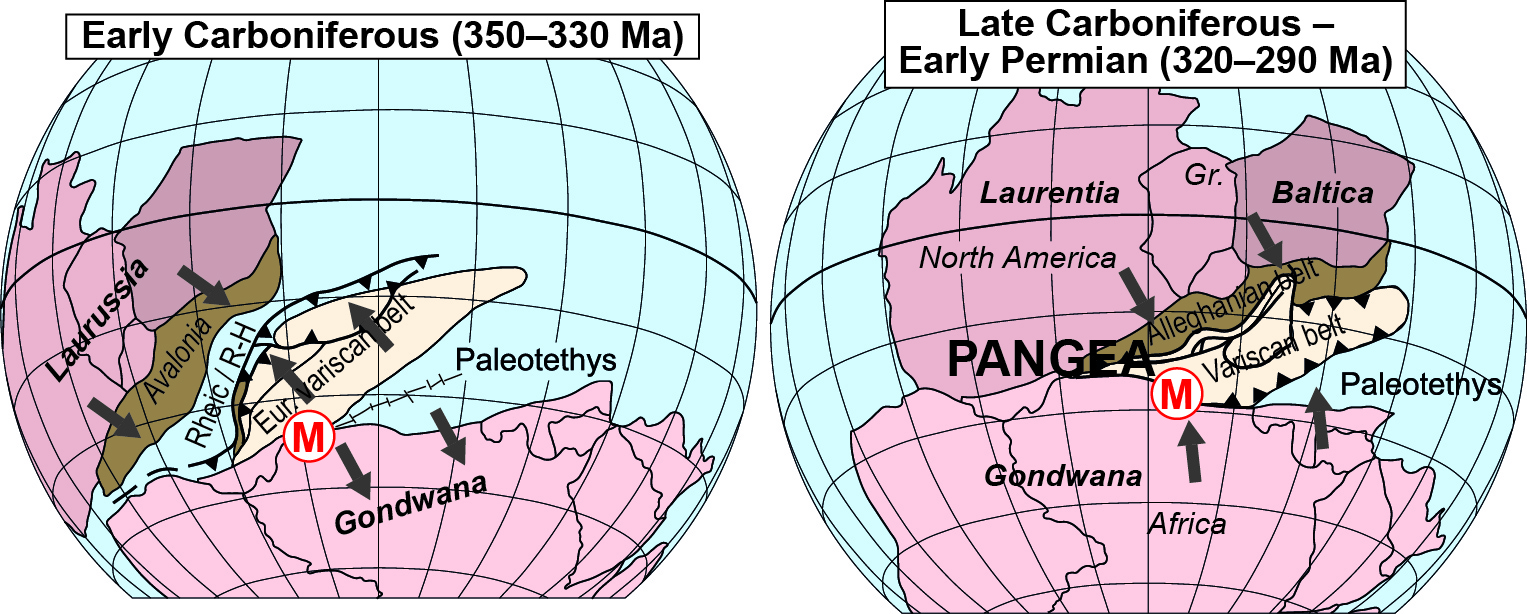Dynamics of collisional processes in the western part of Pangea
Collisional orogens are characterized by the recycling of crustal material resulting from the amalgamation of continental blocks and deep subduction of a lower continental plate beneath an upper plate. The principal issue studied by the CLR related to continental convergence is the process of formation of (ultra-)high-pressure rocks and their exhumation either along the plate interface or within the orogenic root domain. This process resulted from complex interactions between colliding microplates amalgamated prior to major reconfiguration of Laurussia and Gondwana (in Europe and Northern Africa) resulting in complex mechanical interactions along a wide zone suturing of the Pangea supercontinent.
New concept of the European Variscan belt – mid-Variscan allochthon and subduction of Mirovoi ocean crust
Recent studies from the Iberian, French and east European branches of the European Variscan belt have allowed to define a giant SW-NE trending allochthonous body called the mid-Variscan allochthon [link]. The allochthon is highly non-cylidnrical, thin oceanic in the west and thick continental, possibly derived from Baltica, to the east as also documented by geophysical continental-scale data. The current research is oriented towards along-strike and across-strike P-T-t variations and detrital-zircon studies allowing proposal of new paleo-geographic evolution of the European continental crust from Rodinia dispersal to Pangea amalgamation [link] [link] [link]. One of the main results is the redefinition of the age of the oceanic crust involved in the formation of the belt, which seems to be late Proterozoic and not Ordovician (Rheic) as previously suggested [link] [link]. The character and paleogeography of this Proterozoic oceanic lithosphere is currently one of the main studied questions.
Paleogeographic model depicting location of Neoproterozoic - early Paleozoic accretionary belts which will be incorporated in the core of the Pangea supercontinent during the Caledonian and Variscan orogenic cycles. The model begins from the final dispersal of the Rodinia supercontinent (a), upto to the amalgamation of the Gondwana mega-continent (b-c) and opening of the Cambro-Ordovician Rheic Ocean (d). The model is developed from paleo-magnetically constrained reconstructioons [link] and demonstrates how a fragment of old oceanic lithosphere belonging to the exterior Rodinia Mirovoi Ocean (darker blue) became captured between the autochthonous (orange) and allochthonous (pink) parts of the Variscan Orogen. It is hypothesised that the capture of this old and likely dense oceanic lithosphere and its eventual subduction controls much of the early mechanical development of the Variscan Orogen.
Relamination, trans-lithospheric diapirism and channel flow in collisional orogens
In the Bohemian Massif, Eastern Variscan belt, the convergence of two contrasting lithospheric domains resulted in a remarkable sequence of tectonic processes. Attenuated felsic meta-igneous crust was subducted under the rifted (Gondwana) margin formed by a dense sequence of metasedimentary and metabasic rocks. The light crust of the lower plate detached from the rest of the subducting lithosphere, a part of it exhumed back along the subduction zone and the rest formed a lower crustal allochthon attached to the upper plate – the so called "relaminant" [link] [link] [link] [link]. The relaminant was probably emplaced by trans-lithospheric diapirism: The subducted continental material spread laterally beneath the upper-plate lithosphere and eventually buoyantly rose through it into the crust [link] [link]. Melting of the continental material and of the adjacent hydrated mantle and melt-induced weakening of the upper plate facilitated this process. Finally, the over-thickened orogenic crust was subject to lateral spreading enhanced by erosion at the flanks of the orogen. A channel flow in the middle crust developed in a similar manner as that proposed for Southern Tibet and Himalaya [link]. In the Bohemian Massif, the channel flow interacted with the gravity-driven redistribution of the light granulitic lower crust and denser rocks of the upper plate [link] [link] [link]. All these processes have been studied at the CLR not only by means of geological methods, but also using numerical simulations.
Left: Geological map of the St. Leonhard complex, interpreted as a "blob" of subducted and diapirically exhumed crust. Right: Detail of a thermo-mechanical numerical model of trans-lithospheric diapirs. [link]
Suturing the Pangea supercontinent in Europe – opening and suturing of the Paleotethys Ocean
Our studies show that the formation of Pangea supercontinent is a two stage process which started by west directed amalgamation of N-S trending continental ribbons driven by movements of Panthalassan (Paleopacific) convective cell from Silurian to Early Carboniferous times. The rapid anticlockwise rotation of Gondwana related to closure of the Paleotethys Ocean led to shearing and folding of N-S trending of the previously assembled Variscan Belt [link]. The geodynamic records of the two main orogenic events are currently studied in both African and European continents [link]. The kinematics of block amalgamation, role of transcurrent faults on block rotations and final N-S shortening of the belt are currently examined using both structural-geochronological techniques and paleomagnetic surveys.
Contrasting evolution of the Variscan belt in the Late Paleozoic. The north-western edge of Gondwana (M) is affected by intracontinental extension at the tip of the Paleotethyan oceanic propagator in the early Carboniferous before Pangea amalgamation in the late Carboniferous-early Permian. [link]
Related projects
Origin of the relaminant in the Bohemian Massif during the Variscan orogeny (2023–2025)
Granulite-migmatite domes - insight into the Devonian and Carboniferous development of the Variscan belt (2019–2021)
The role of inherited continental margin architecture on early Variscan convergence (2017–2019)
The role of Paleozoic accretionary and collisional orogens on the formation and growth of continental crust (2012–2016)



